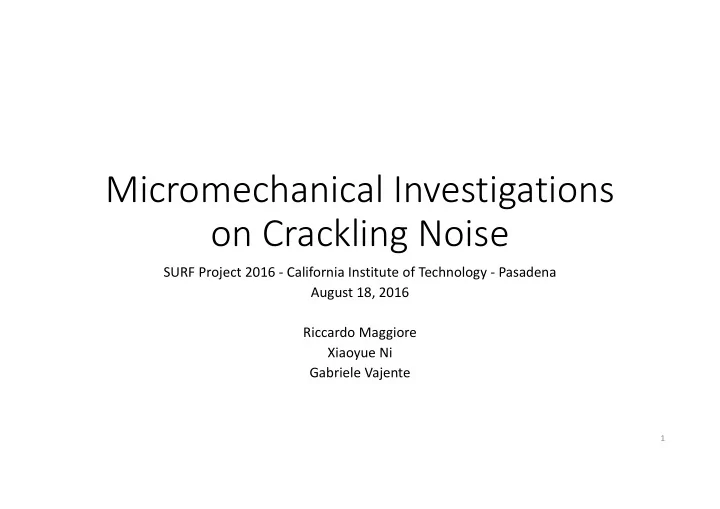

Micromechanical Investigations on Crackling Noise SURF Project 2016 ‐ California Institute of Technology ‐ Pasadena August 18, 2016 Riccardo Maggiore Xiaoyue Ni Gabriele Vajente 1
Aim and Introduction • Advanced LIGO suspensions are loaded within the macroscopically elastic regime • Non linear deviation from a simple linear relation between strain and stress. • Discrete releases of energy ( Crackling Noise Phenomenon ). • Noise can propagate to the test mass and it is a potential up‐conversion noise source. 2
Aim and Introduction Non‐Linear Deviation from a simple linear relation (No Theoretical Model) Could up‐convert low frequency excitations of the metals into high frequency (Audio Band) noise in their elastic regime We have adopted a theoretical constitutive model conceived for the plastic regime and translated it into a code This is a numerical simulation work. The first part is focused on a parametric study where I have run several simulations at a time with varying parameters. 3
Experimental Introduction 4 X. Ni, "Micromechanical Investigation on Crackling Noise, Crackle Meet @Pasadena" (2016)
Data Analysis Experimen t Simulation � � � 5
Theoretical Model Microplasticity: Avalanche Condition : ����, �� � � � ���� � � ��� � � ��� � � ��� � � ��� ��, �� � ���� � 0 � ��� ��, �� � � ��� ��� � � ��� ��� � ��� ��� � � sin ��� � �� � � � � � � � � � 1 � � � � � � � � � �� � � � � � � ��� � � � � � Stefanos, J., Papanikolaou, et. al. Nature 490, 517–522 (2012) Michael Zaiser, Advances in Physics, 55:1‐2, 185‐245 (2006) 6
Data Analysis Experimen t Simulation Fixed Parameters: � � 3.1 10 �� 1/� • • � � 3000 ��� Gaussian D. ‐ � � 1.00 7 •
Standard Fixed Parameters: � � 5 · 10 �� • Parametric Study Results • � � 400.0 • Gaussian D. ‐ � � 0.50 � � � � � ��� � � �� � � � � ����, �� � � � � ��� ��, �� � � 8
Crackling Simulation � � � � �� � � � �����2�� �� � � � � ∆� � � � � � � 9
Fixed Parameters: � � 3.1 10 �� 1/� Crackling Experiment Results • • � � 3000 ��� • Gaussian D. ‐ � � 1.00 10
Future Work • Implement the crackling‐noise‐experiment like loading condition and carry out different frequency; • Imput the developed micro‐mechanical simulation results into the scaling model [1]. [1] G.Vajente, ”Crackling Noise: Scaling Model”, LIGO‐T1600246‐v2 (2016) 11
Special Thanks • Xiaoyue Ni , I want to thank you for all you have taught me. The knowledge and wisdom you have imparted upon me has been a great help and support. • Gabriele Vajente , I will always be grateful to you for your support and kindness. • Viviana Fafone, Alessio Rocchi, INFN‐Virgo , for guiding me towards the right path. 12
Recommend
More recommend